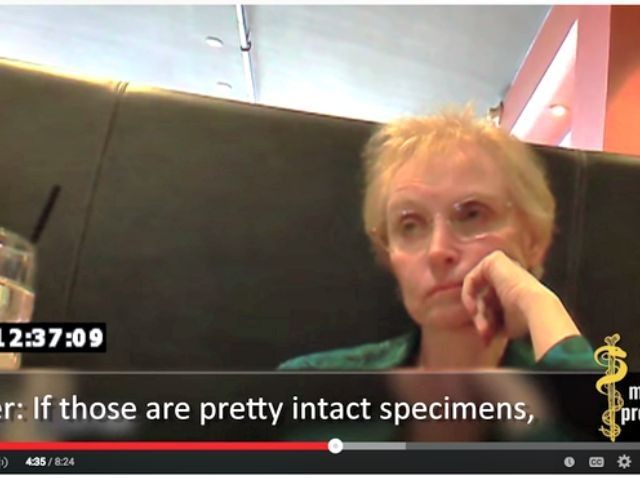The New York Times weighed in on the Planned Parenthood sting videos Wednesday with an editorial that reads like a press release for America’s largest abortion provider. Like a press release, the Times‘ editorial conveniently omits any evidence which might tend to undercut its claims.
The key contention in the Times‘ piece is that Planned Parenthood is definitely not selling baby parts for money. “A hidden-camera video released last week purported to show that Planned Parenthood illegally sells tissue from aborted fetuses. It shows nothing of the sort,” the piece opens. Given the centrality of this claim, it’s worth asking what evidence the NY Times offers to prove it. All of the proof is condensed into one paragraph:
The full video of the lunch meeting, over two hours long and released by the Center for Medical Progress after complaints by Planned Parenthood, shows something very different from what these critics claim. Clearly, the shorter version was edited to eliminate statements by Dr. Nucatola explaining that Planned Parenthood does not profit from tissue donation, which requires the clear consent of the patient. Planned Parenthood affiliates only accept money — between $30 and $100 per specimen, according to Dr. Nucatola — to cover costs associated with collecting and transporting the tissue. “This is not something with any revenue stream that affiliates are looking at,” she said. Under federal law, facilities may be reimbursed for costs associated with fetal tissue donation, like transportation and storage.
The NY Times claims twice in one paragraph that Planned Parenthood was charging money for “costs associated with collecting and transporting the tissue.” That’s the same claim Planned Parenthood has made. It’s the only claim they can make and still avoid admitting they broke the law.
But is it true?
Not according to Dr. Nucatola who said, in another clip cut from the first video, “They want to break even. And if they can do a little better than break even, and do so in a way that seems reasonable, they’re happy to do that.” Doing “a little better” than breaking even is called a profit. Perhaps not a large one given the danger of being caught breaking federal law, but a profit nonetheless.
It became even more clear that Planned Parenthood was not charging simply for “collecting and transporting” tissue once the second video was released. In the 2nd video clip, Dr. Gatter, the former medical director for PPLA, described how the donations actually took place:
So Novogenix was our partner in PPLA and they would send us- you know, big volume. They would send their staff to the site…and Heather would look at the tissue…she would take the pieces that she wanted and it worked out well for everyone. She was unobtrusive, she was helpful, she did all that kind of stuff.
Novogenix would send their staff to collect the tissue and take it away. That “worked out well for everyone, according to Dr. Gatter, in what seems like an obvious reference to a financial arrangement. A bit later Dr. Gatter makes it explicit what Planned Parenthood did to earn this money [emphasis added]:
So Heather, a Novogenix person would come to the site, and our staff would sign the patients up, and get consent. Heather would look at the tissue and take what she required, so logistically it was very easy for us, we didn’t have to do anything. There was compensation for this, and there was discussion if that was legal, they have been paying by the case, and there was some discussion about do we, in a different way, or I don’t know what you’re used to doing, how you’re used to doing compensation.
This is what you call a smoking gun. Not only does Dr. Gatter admit Planned Parenthood “didn’t have to do anything, she also admits “there was discussion if that was legal.” As the NY Times helpfully points out, Planned Parenthood can only charge for “transportation and storage.” In this case, none of those expenses applied. Novogenix was collecting, storing, and transporting the tissue using their own staff and resources. Planned Parenthood was being paid for nothing other than access to the fetal organs. Not only that, Planned Parenthood knew the situation was probably illegal and raised the issue of how to rearrange the payments to disguise that fact. And of course, this is not even mentioning Dr. Gatter’s “joke” about wanting a Lamborghini.
The Times editorial board also fails to look at compelling evidence (in both videos) that Planned Parenthood was altering how procedures were performed in order to produce useable organs. That’s a violation of the consent forms patients were asked to sign. There was also some discussion of ways to skirt the partial birth abortion ban, which deserves further investigation.
Incredibly, the NY Times managed to miss all of this this when writing its blithe and misleading editorial. At least, that’s the most positive spin one can put on this piece. It’s also possible the Times knew exactly what was in the videos but decided not to confuse readers with the facts. The Times has never been accused of playing it straight on the issue of abortion.

COMMENTS
Please let us know if you're having issues with commenting.